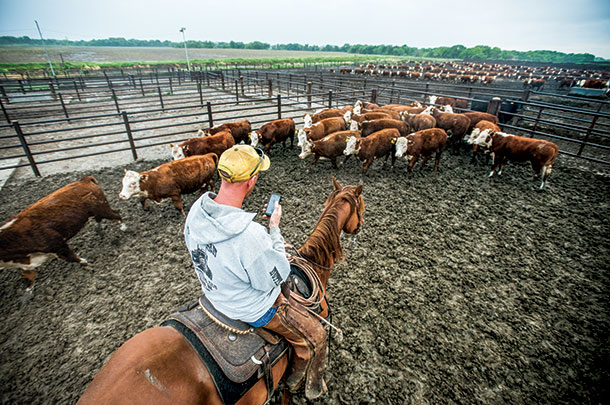Even if the cat resembled death the minute before, if there is any spunk left, the claws and teeth shred your shirt sleeves to ribbons as he continues hissing into the bottom of the bag.
If you have been unbagged, I mean, admitted to the hospital for more than a few days, you realize: 1) the walls get smaller every day, 2) your grip on the little red button relaxes as you feel better, and 3) your thoughts wander.
Think about the life of a nurse before that little red button. The nurse would stride through the halls, patrolling the rooms, even the bright-eyed, on-the-mend patients. Tick-tock-tick-tock.
Think of the wasted minutes checking on healthy clients, who yell at the nurse for waking them from their nap. What about the severely ill teetering on the edge of death? Or the stitch-in-time patients whom timely medicine would cure? Too bad the nurse was checking on the healthy lot.
Your thoughts drift from hospitals to feedyards. The average pen rider patrols the lots, on average eyeing 4,000 to 7,000 head daily – a mere four seconds per head to declare the animal “healthy” or “sick.” Can you imagine how helpful that little red button could be to the feedlot labor and the sick animals?
For the last couple years, the company, Quantified Ag, envisioned, created and just finished testing a little red button for sick cattle. But the little red button is actually an electronic ear tag. And instead of the nurses’ station, your smartphone receives the alert.
“We saw a need in the feedlot industry and created a simple, user-friendly product,” says Vishal Singh, CEO. Why the feedlot setting? The feedlot provides a concentrated number of animals, whose health is evaluated in seconds.
As death losses creep up for many feedlots, a tool like this electronic ear tag can greatly improve herd health, especially for light, high-risk calves.
Reading the signs
The team, including Andrew Uden (COO), Brian Schupbach (CTO) and Alex Heine (product development), succeeded in developing an easy-to-use product that saves time, money and the ability to doctor animals before physical symptoms appear.
The ear tag collects vital signs directly from the animal, beams the information to a receiver, then a computer or smart device is notified with the tag numbers of the sick animals.
Unlike a normal dangling ear tag, this cylinder-shaped ear tag nestles inside the top curve of the ear (the part of the ear you clean out before tattooing).
The ear tag is quickly clipped to the ear during processing with a companion air gun and staple, specially designed to work with the ear tag. Whiiish, clip, done.
The first signs of a sick animal are higher temperatures and less activity. The body temperature is monitored by a laser pointing down the ear canal, biometrics (the behavior of the animal) and range of motion is monitored for decreased movement (indicating a sick animal). Other components tucked in the small cylinder of the ear tag include RFID (radio frequency identification) and a LED light.
When an animal’s symptoms trigger a threshold, the pen rider’s cell phone notifies them of the sick animal. Pen riders trot directly to the pens with sick animals, while overlooking the healthy pens.

From Uden’s experience in feedyards, 50 to 60 percent of the pens are healthy and do not need attention from the pen riders. “Your labor is now concentrated to where the sick animals are.” Not only is the labor now concentrated, but the sick animals are easy to spot.
The visual tag number of the animal is displayed on your phone and the LED light in the tag glows. The days of squinting at visual tags is over. Now sick animals light up in the pen.
There is only one piece of equipment we haven’t talked about – the receiver. The ear tag communicates every hour with a receiver that is usually placed on the feedmill. The receiver converses with tags in a two-mile radius and can handle 62,000 ear tags. (Multiple receivers can be set up for more cattle and larger areas.) The receiver sends the information to the “cloud” where it can be accessed through computers or mobile interfaces.
The benefit for cattle
With all this technology, the price is surprisingly economical. The company estimates the total system cost is less than $20 per head, calculating out to 7 to 10 cents per day per head. Uden reflects on the benefits: catching sick cattle early and using less costly and lower doses of antibiotics to treat less severe cases.
The labor of the pen riders is also focused on the sick animals. “Your ratio of pen rider to cattle is now 1 to 1, when before it was one guy overseeing thousands of head.”
Feedlot managers are able to calculate the benefits by receiving meaningful data in the form of simple spreadsheets. Percent sick, doctored and death loss can all be calculated. Feedlots can also track healthy, performing pens back to the producer, and continue to purchase calves from those farms or ranches.
The gentle beep of your heart monitor brings you back to reality; the reality you are still in the hospital. But wait – are you seeing things from the high-powered drugs dripping into your IV? Or is that the nurse with a pneumatic air gun, ear tag and dismissal papers looming towards you? Whish, clip. ![]()
PHOTO 1: The body temperature is monitored by a laser pointing down the ear canal, along with behavior and range of motion.
PHOTO 2: When an animal’s symptoms trigger a threshold, the pen rider’s cell phone notifies them of the sick animal. Photos courtesy of Quantified Ag

-
Bethany Johnston
- Beef Educator
- University of Nebraska Extension
- Email Bethany Johnston








